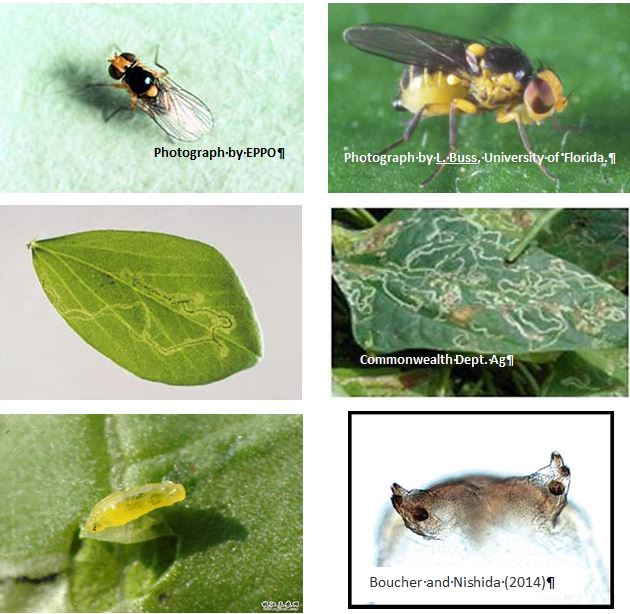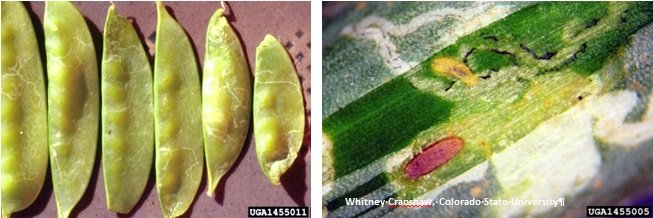Background
A new leaf-mining fly, the vegetable leafminer (Liriomyza sativae), has recently been found at Seisia on the western side of the top of Cape York, Queensland. Originally from the Americas, since the 1980s this pest has spread westwards across the Pacific into Asia and has been island hopping across Torres Strait since 2008. Any suspected sightings of the pest should be reported as soon as possible to the National Plant Pest Hotline on 1800 084 881. If found in a pulse crop, also contact DAF senior entomologist Hugh Brier on 0741 600 740 or 0428 188 069.
The pest is in the same group of flies (the Agromyzids) as the ordinary bean fly (Ophiomyia phaseoli) and soybean stemfly (Melanagromyzae sojae). It has a wide host range that includes summer pulses. Adults are wind borne and eggs, larvae and pupae can be moved on plant material (e.g. nursery plants), soil, clothing and equipment. Large numbers can cause considerable damage. Growers and consultants are urged to keep a look out and report any suspected outbreaks.

Fig. 1 (From top): Vegetable leafminer adult flies. Note the yellow patch between the wing bases, and the yellow face and underbody; Typical convoluted leaf mining damage; A large yellow larva, and the distinctive posterior larval spiracles each with three bulbs.
Identification
Vegetable leafminer (VLM) adults are only 1.5 mm long and are easily distinguished from beanfly and soybean stemfly by the yellow patch between the base of their wings, and their yellow face and underbody. In contrast, bean fly and stem fly adults are mostly black. The closely-related American serpentine leafminer (NOT yet reported in Australia) has a similar colouration to VLM, but the top of the thorax is a matte dark gray, not a shiny black.
The elliptical eggs are pale white and 2 mm long and are laid into the leaf.
There are three larval instars. Larvae are initially translucent, progressing to pale green, and finally to yellow in the final instar, which reaches 2.25 mm long. The larvae are legless maggots with dark hooked mouth parts, but no head capsule. VLM larvae are distinguished from bean and stem fly by their feeding habits (mining in leaves) and by their distinctive posterior spiracles, each with three bulbs (see Fig 1). For bean fly larvae, the posterior spiracles are shaped like little trumpets, while those of stem fly are shrunken (atrophied).
VLM pupae are reddish brown and reach 1.5 mm long.
Hosts
Vegetable leafminer has a wide host range. Pulses attacked include cowpea, field pea, lima bean, mungbean, navy bean, pigeon pea and soybean. Other crops attacked include brassicas, cotton, lucerne, onions, potatoes, and tomatoes, as well as a large number of weeds.
Lifecycle
Vegetable leafminers can lay 300 to 400 eggs per female. Mature larvae leave the mines, usually exiting the leaf through a pre-cut semicircular slit and dropping to the ground to pupate. However, they sometimes pupate in the leaf mines. The life cycle takes only two weeks in warm weather, with about two days for eggs, five days for larvae, and seven days for pupation.
Damage symptoms
The pest is primarily a leaf feeder, but can also damage petioles, and soft succulent pods, as in field peas. Punctures caused by feeding and egg-laying females may cause a stippled appearance on leaves and stems, however this damage is negligible compared to the larval leaf mining activity. VLM larvae feed under the surface of leaves (in leaf mines) and petioles causing long, narrow ‘mines’ which appear as white or grey lines on leaves. Severe damage may kill leaves, and affects the plant’s ability to photosynthesize, thereby reducing plant growth, and reducing crop yields. In some vegetable crops, the cosmetic damage alone has a major impact on crop value. While bean fly and stem fly also lay eggs in leaves, their larvae usually move down the plant through the petioles to the stems, the former feeding in the vascular tissue, and the latter in the stem pith. In crops suffering late bean fly attack (particularly in navy beans), damage may be restricted to the leaves and petioles, but there is not the distinctive leaf mining of VLM.
Other pests it may be confused with
The leaf mines may be confused with those made by other leafminers, especially in soybeans which hosts soybean moth and soybean leafminer. However the mines made by these caterpillars are much broader and are not as convoluted or elongated. Also these two caterpillar pests have legs and well-defined head capsules. In cotton, damage could be confused with mines made by small cotton leaf perforator (caterpillar) larvae, before they go into perforation mode.

Fig. 3: Mines (blisters) made by small soybean moth larvae, and medium soybean moth larva (4.5 mm) Joe Wessels DAF

Fig 5: Cotton leaf perforator damage and large larva (9 mm). Note the scribbly mines made by small larvae and the perforations made by larger larvae. C. Mares CSIRO
Monitoring
The distinctive leaf mines should give early warning of a building attack. Adult flies can be monitored with sweep nets or sticky traps. Also look for VLM activity in earlier-planted crop hosts.
Control
No chemicals are currently registered for the control of vegetable leafminer in Australia. It is likely that an emergency use permit could be secured for its control in the extent of an outbreak.
There are a number of small native chalcid wasps attacking bean and stem flies that could attack this new pest. Field observations of a recent soybean stem fly outbreak in the Casino region showed increased parasitism as the summer progressed.
Please report suspected outbreaks
If you suspect you might have a VLM infestation, report it to the Exotic Plant Pest Hotline on 1800 084 881. If in pulse crops, also please contact DAF senior entomologist Hugh Brier on 0741 600 740 or 0428 188 069.
More information on vegetable leafminer can be found at
http://www.planthealthaustralia.com.au/pests/vegetable-leaf-miner/


